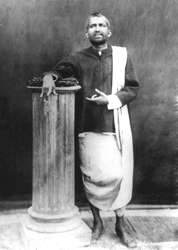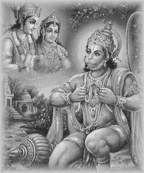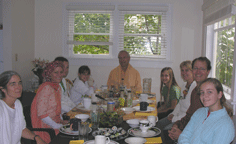When our older SRV children were very young we taught them through rituals, stories, drama, and art. Core philosophical and dharma teachings were expressed in that manner. Now, as they are entering the later grades of elementary and middle school, they are naturally interacting in a more intellectual way with the external world (the bhutakasha) and having more involved social interactions as well. In our secularized society it is essential for the children of dharmic families to have friendships with other children whose home life is also based in dharma, otherwise they feel out of step with their peers. For the children of parents who follow Vedanta, this can be a real challenge, since we are not a large group in any city. Therefore, at SRV's Portland ashram, we work hard at finding times our children can come together for formal spiritual instruction in the ashram, and have fun in the process.
What is fun at 5 and 6 years of age is not so fun for 11-year-olds. When this writer was a young mother attending the Portland Vedanta Society, I was asked by Swami Aseshanandaji to be a Sunday school teacher. "What should I do?" I asked. And Swami replied to the effect, "let their interests guide you." At that time I also asked him about some children's stories I was writing. He brushed my immature ideas aside and said to tell the stories of Sri Ramakrishna. Twenty years later these two instructions have been integrated in a special way, especially for our older SRV kids. The stories of Sri Ramakrishna contain many examples that can be re-enacted like experiments and used as a basis for discussing spiritual truths and methods of sadhana. This age group is fascinated by how things work in the material world, and they are also ready for complementary teachings of a philosophical nature that provide tools to meet, or at least reflect, on their experiences and reactions to the world. Learning to observe the mind, its thoughts, desires, emotions, and intuit the Witness who does this, cannot begin too early in life. It is really essential that these teachings be started well before the teenage years.
<S><R><V><><O><R><E><G><O><N>
Last September, the Portland ashram held its first overnight retreat for children ages 9 and older. Four 11-year-old girls participated in their own classes and activities, as well as in the ashram life of morning meditation, meals, preparation of the shrine for puja/worship. They even attended part of one of Babaji's classes. For their own classes, we focused on unwrapping Sri Ramakrishna's well-known teaching drawn from photography.
 Sri Ramakrishna lived in ceaseless states of bliss and ecstasy. It was as though he had a divine screen before his mind and senses causing everything he saw to remind him of God or the pathways to realizing God. Photography was a new science back in the late 1880's and he was curious about it. Some devotees took him to the studio of Bengal Photographers in Calcutta, India. This is what he experienced:
Sri Ramakrishna lived in ceaseless states of bliss and ecstasy. It was as though he had a divine screen before his mind and senses causing everything he saw to remind him of God or the pathways to realizing God. Photography was a new science back in the late 1880's and he was curious about it. Some devotees took him to the studio of Bengal Photographers in Calcutta, India. This is what he experienced:
"Today I enjoyed very much seeing the machine by which a man's picture is taken. One thing I noticed was that the impression doesn't stay on a bare piece of glass, but it remains when the glass is stained with a black solution. In the same way, mere hearing of spiritual talk doesn't leave any impression. People forget it soon afterwards. But they can retain spiritual instruction if they are stained inside with earnestness (utsaha) and devotion (bhakti)."
This series of thoughts struck his spiritually sensitive mind causing him to enter into samadhi, a state of divine absorption. The picture accompanying this article is the very picture taken on that day, December 10, 1881 of Sri Ramakrishna in samadhi.
DAY 1
Our first day's activities began with morning devotions and meditation. Taking turns, the children recited mantras from the Vedas along with their English translation and then sat for a short meditation. During the study part of the children's classes we focused on how mental impressions are made and on the presence of the witness of these impressions. The children were asked to think about and then discuss the following ideas, which they took turns reading aloud:
 Hanuman, in the picture at left, is shown opening his heart, on which Rama and Sita are firmly imprinted. This heart is not the physical heart, but the "secret heart" which is the seat of the higher mind and Atman. In other words, in Hanuman, the Atman takes the form of his Ishtadevata, his Chosen Ideal, Rama and Sita.
Hanuman, in the picture at left, is shown opening his heart, on which Rama and Sita are firmly imprinted. This heart is not the physical heart, but the "secret heart" which is the seat of the higher mind and Atman. In other words, in Hanuman, the Atman takes the form of his Ishtadevata, his Chosen Ideal, Rama and Sita.
Ideas to Ponder......
- The mind takes the form of what it thinks about. This includes hearing, seeing, tasting, touching, and smelling. The mind is like fire, and our thoughts are objects thrown into it. The mind-fire takes their shape.
- "To know many things is ignorance. To know one thing is knowledge." What did Sri Ramakrishna mean by this?
- "In the beginning of spiritual life, God is the magnet and the devotee is the needle. But at the end, the devotee becomes the magnet, and God becomes the needle. One attains God who has longing."
- "Yearning is like the red sky in the east at dawn. After such a sky, the sun must rise. Immediately after that yearning one sees God."
- How is it possible for Rama and Sita to be imprinted upon Hanuman's heart?
Next we read and talked about the following:
"That one attains immortality who recognizes the Atman in and through every modification of the mind." - Kena Upanisad
The mind is like a bowl of water. It reflects whatever is close to it. The Atman, our true Self, is like the sun that provides the light that lets us see the reflections. Objects, and the thought of objects, reflect in that mind-water. A restless mind gets a distorted image. A calm mind sees objects clearly. A spiritually earnest and devoted mind sees the Light that illumines all — the mind, the objects, and the Self.



As part of the discussion, the teacher held out her hand and asked the kids, "What do you have to know before you can see my hand?" There was a little shock at the question at first, and then they realized how subtle the riddle was. Initially, they responded at the physical or energy level,"I'm alive!" and then they jumped to a conceptual level. "I am" said a couple girls. "That is only a concept in your mind," said the teacher who could tell they were only repeating things they had heard from parents, but not thinking it through. After working at this for sometime, these young persons began to get a sense of the Seer who only sees but is never seen - that we are inherently aware of our existence and that precedes all other perception. It was beautiful and so inspiring to see this understanding dawn on their faces.
The reading continued: In the early days of photography, it took a long time to expose the image on the glass plate. This is why we do not usually see people smiling in those old photographs. They had to hold their position a long time - too long for a posed smile to feel or look natural.
Notice the picture of Sri Ramakrishna standing in samadhi. He is smiling! He was photographed while he was in samadhi, which means that he is seeing God. His experience of God's bliss was so intense that they had to put the pillar next to him so he would not fall down. This kind of blissful love is called Prema, a love that is so complete that a person forgets about her self or her body. It is a perfectly selfless love. Imagine how long Sri Ramakrishna must have been in this state of bliss for the photograph to come out so clear.
God/Atman is formless, but takes the form of our Chosen Ideal to help us concentrate our minds. Loving concentration brings us close to God, protects us, and gives peace.
The Dark Room
After a very thoughtful discussion on all these ideas, we turned to the experiment part. In fact, the kids could not wait to enter the makeshift darkroom created in the closet in the back of the shrine room. We had secured some photographic chemicals to make old fashioned cyanotype prints from a place in Montana, gathered papers, brushes, a darkroom light, and a "light box" made from a card board box with a "happy light" placed over it. There was a sign posted outside saying "do not enter." We crowded into this room with its severely slanted ceiling as efficiently as possible, short people to the back and tall ones to the front and let our eyes adjust to the red light. 


Before this, each girl had Googled some favorite pictures or brought some along, and together we took them into Adobe Photoshop and turned them into negatives. Next we printed them out on transparencies. Joila! We had negatives to put over papers. Now, in the dark room, we took our papers coated with light sensitive chemicals and placed the negatives on top, and set them in the cardboard box with the happy light over it and waited for them to develop. Time for lunch!
A Trip to the Pixie Project



A portion of time was set aside in this retreat for some seva, or service. Before embarking on this we reminded ourselves of the principles of Karma Yoga: selfless work and no attachment to the results. The children wanted to do their seva at an animal shelter and thus we found ourselves at the Pixie Project near the riverside in downtown Portland. We were met by friendly staff who were pleased to have a crew of helpers all of a sudden. Immediately the girls had to focus on nonattachment to results, however, for their hope had been to take the dogs for walks or get to groom them. Instead, and they were happy to do this, we cleaned the kitty room and petted the cats, and then sat down at a table with a huge box of small peanut butter doggie biscuits that had to have a hole drilled through each one (using a paper clip for a drill) and a ribbon and card tied on. It is an ongoing awareness raising project for the Pixie Project. So the girls worked at this, assembly line fashion, and in the end got to walk one of the dogs, or rather, help their teacher walk the dog since they were not 16 years, the minimum age for this privilege. We had a lovely walk along the riverfront and over the Steel Bridge, before returning to the ashram.
Puja and a Silent Night
It was now time to have a snack and then help prepare for the puja tonight. The children also checked to see how our cyanotype prints were coming along. Teacher and kids were novices in photography, so the results, though interesting, had a lot of room for improvement. We checked our processes and decided to try again the next day.
Together with Babaji, parents, and sangha, the children observed and participated in the beautiful worship of Sri Ramakrishna, Holy Mother and Swami Vivekananda. Flowers, music, candles, and incense were offered and we all bathed in the "impression-sticking" atmosphere of devotion. Afterwards, we had a prasad dinner together. Not surprisingly, the result of housing four 11-year-old girls in one room was an escalation of hilarity, but definitely too rajasic for night time when peace should descend before entering into sleep. Babaji gathered them up in the shrine room for meditation and other instructions conducive to sattva, peace, and balance. Later they were "administered" a vow of mauna, silence, until morning.
DAY 2
Morning meditation was followed by breakfast. Then we met up in the back of the shrine to review yesterday's class and proceed to the next lesson. In contrast to the first class that was centered more on mind and awareness, and how impressions are made, this next class focused on a natural way to cultivate devotion. The children took turns reading the following lesson, pausing for discussions along the way.
Pancha Maha Bhava <> The Five Divine RelationshipsSri Ramakrishna taught us in this modern age that it is essential to have a particular "bhava" or relationship mood with our Chosen Ideal. These moods help us feel the presence of God in our minds, hearts, and all around us, just like we do with people we love in our lives.
If we do not have a relationship with others, then we do not feel close to them. We feel separate and unconnected to them. Because God is all-pervasive (everywhere and inside everything), this is the most powerful relationship we can have. When we are close to God inside ourselves, that closeness soon includes everyone and everything in a special way. This is why the saints and sages are able to love all people and creatures. This is why they are joyful, peaceful, unselfish, and compassionate.
Sri Ramakrishna once asked his young disciple, Sharat, "What do you want?" Sharat, who was still very young replied, "I want to see God in everything." "Oh," said Ramakrishna, pleased with his student, "That is the last word in spirituality here in this world. It will take time." The young Sharat vowed to realize this state, and he did.
We usually speak of 5 moods:
shanta: the mood of peace,
examples: the Vedic Rishis
dasya: the mood of being a servant of God
examples: Hanuman, Ramakrishna & Holy Mother as handmaids of Mother Kali
sakya: the mood of being a friend of God
examples: The Gopas, Balaram, Lakshmana
vatsalya: the mood of looking upon God as your Child or as your Mother or Father
examples: God as Child: Yashoda, Mother Mary, Kausalya, Gopal Ma
examples: God as Parent: Jesus, Ramakrishna, Ramprasad
madhura: the mood of looking upon God as your Sweetheart/ Beloved
examples: Radha, Gopis, Christian Saints, Rumi
 Hanuman represents the dasya bhava (mood). Sri Ramakrishna practiced all these bhavas and more and experienced divine visions and samadhi in each of them. It is rare for a person to reach perfection in even one mood, but he realized God in all of them. When Sri Ramakrishna practiced the dasya bhava, he concentrated on Hanuman and imitated his absolute devotion to the service of Sri Ram and Sita. Ramakrishna's concentration and identification with Hanuman was so complete, that his tail bone got longer for awhile. Others actually saw this! While practicing this sadhana (spiritual practice), he had the vision of Sita.
Hanuman represents the dasya bhava (mood). Sri Ramakrishna practiced all these bhavas and more and experienced divine visions and samadhi in each of them. It is rare for a person to reach perfection in even one mood, but he realized God in all of them. When Sri Ramakrishna practiced the dasya bhava, he concentrated on Hanuman and imitated his absolute devotion to the service of Sri Ram and Sita. Ramakrishna's concentration and identification with Hanuman was so complete, that his tail bone got longer for awhile. Others actually saw this! While practicing this sadhana (spiritual practice), he had the vision of Sita.Sri Ramakrishna's natural relationship with God was to feel that he was the child of the Divine Mother. Although he practiced all the other moods, this was the bhava he always returned to.
More Ideas to Ponder......
How do we develop earnestness for God?
Which of the 5 Moods seem natural to you?
Someone asked Sri Ramakrishna: How can we make our devotion steady and permanent?
Ramakrishna: If you hang a jar of water with a sling in your room, the water will dry up after a few days. But if you keep your jar under the surface of the Ganges river, it will never dry up. If one's mind is immersed in the all-loving God, one's love and devotion never dries up.
Sushi Anyone?
After our studies we made a fresh foray into our photographic experiments, cramming ourselves into the darkroom and putting on gloves and applying the negatives again. We set the timer on the "happy light" and went down to attend the the second part of Babaji's class. Babaji had the kids wait for the second half so that he could complete certain teachings (for the adults) begun the day before, but in the second half he had some stories to present.



As the children's final seva/karma yoga project and offering, they made a sushi lunch for Babaji and Loke, teacher, and parents. Most of our children's classes over the past year have included cooking, and the girls are already quite adept in the kitchen. In the ashram and at our summer retreat, we shift the focus from merely being able to prepare food, to a focus on one's purity of thought and action while preparing food. The meal turned out well. We had mounds of vegetarian sushi, miso soup, and salad and a joyous atmosphere culminating our first children's ashram retreat.
Epilogue: The second set of photo experiments taught us a few more things about what not to do.... and in the next class we will take that knowledge and create holiday cards from light sensitive papers — Mother willing!
SRV EMAIL LIST
Receive news about SRV
Classes, Retreats, New Publications,
Nectar Magazine, and more.

